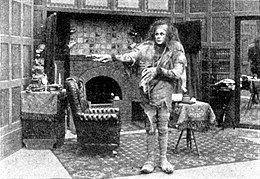Cast
Music
Frankenstein was among the earlier silent films to have an associated
cue sheet, providing suggested musical accompaniment.
[7] From the cue sheet:
At opening:
Andante—"You Will Remember Me"
Till Frankenstein's laboratory:
Moderato—"Melody in F"
Till monster is forming: Increasing
agitato
Till monster appears over bed: Dramatic music from "Der Freischütz"
Till father and girl in sitting room: Moderato
Till Frankenstein returns home: Andante—"Annie Laurie"
Till monster enters Frankenstein's sitting room: Dramatic—"Der Freischütz"
Till girl enters with teapot: Andante—"Annie Laurie"
Till monster comes from behind curtains: Dramatic—"Der Freischütz"
Till wedding guests are leaving: Bridal Chorus from "Lohengrin"
Till monster appears: Dramatic—"Der Freischütz"
Till Frankenstein enters: Agitato
Till monster appears: Dramatic—"Der Freischütz"
Till monster vanishes into mirror: Diminishing Agitato
The pieces include "You'll Remember Me" from the 1843 opera
The Bohemian Girl, the 1852 "
Melody in F", "dramatic music" (presumably the "Wolf's Glen" scene) from the 1821 opera
Der Freischütz, the 1835 song "
Annie Laurie", and the Bridal Chorus from the 1850 opera
Lohengrin.
[10]
Copyright status
The film, just as all other
motion pictures released before 1923, is now in the
public domain in the
United States.
Rediscovery and preservation
For many years, it was believed a
lost film. In 1963, a plot description and stills (below) were discovered published in the March 15, 1910 issue of the film catalog,
The Edison Kinetogram.
In the early 1950s, a print of this film was purchased by a
Wisconsin film collector, Alois F. Dettlaff, from his mother-in-law, who also collected films.
[12] He did not realize its rarity until many years later. Its existence was first revealed in the mid-1970s. Although somewhat deteriorated, the film was in viewable condition, complete with titles and
tints as seen in 1910. Dettlaff had a 35 mm preservation copy made in the late 1970s. He also issued a
DVD release of 1,000 copies.
[13]
BearManor Media released the
public domain film in a restored edition on March 18, 2010 alongside the novel,
Edison's Frankenstein, which was written by Frederick C. Wiebel, Jr.
[14]
In 2016, the
film society of the
University of Geneva undertook their own restoration of the film, with image restoration by Julien Dumoulin and an original soundtrack by Nicolas Hafner,
[15] performed on a Wurlitzer
theatre organ located at College Claparède.
[16] The restored version of the film was shown on 10 October 2016

A still showing Charles Stanton Ogle as the monster.

A still showing Augustus Phillips as Victor Frankenstein
See also





